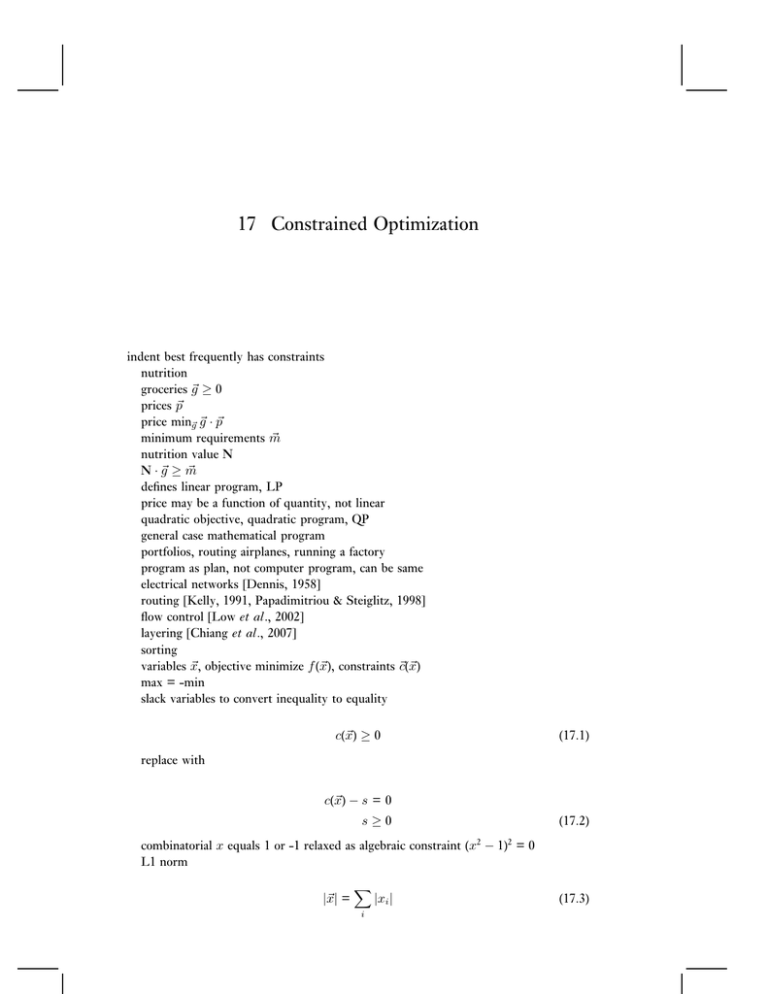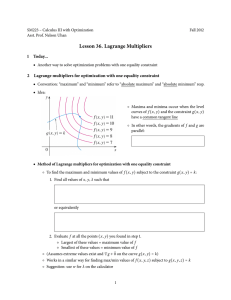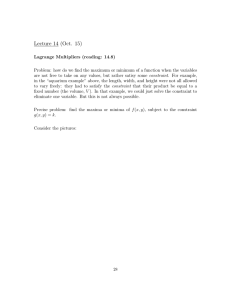17 Constrained Optimization
advertisement

17 Constrained Optimization indent best frequently has constraints nutrition groceries ~g ≥ 0 prices ~ p price min~g ~g · p~ minimum requirements m ~ nutrition value N N · ~g ≥ m ~ defines linear program, LP price may be a function of quantity, not linear quadratic objective, quadratic program, QP general case mathematical program portfolios, routing airplanes, running a factory program as plan, not computer program, can be same electrical networks [Dennis, 1958] routing [Kelly, 1991, Papadimitriou & Steiglitz, 1998] flow control [Low et al., 2002] layering [Chiang et al., 2007] sorting variables ~x, objective minimize f (~x), constraints ~c(~x) max = -min slack variables to convert inequality to equality c(~x) ≥ 0 (17.1) replace with c(~x) − s = 0 s≥0 (17.2) combinatorial x equals 1 or -1 relaxed as algebraic constraint (x2 − 1)2 = 0 L1 norm |~x| = X i |xi | (17.3) DRAFT 17.1 Lagrange Multipliers 213 compressed sensing, sparsity non-differentiable [Schmidt et al., 2007] (x)+ = max(x, 0) (x)− = max(−x, 0) |x| = (x)− + (x)+ |x| ≈ |x|α 1 log 1 + e−αx + log (1 + eαx ) = α (17.4) (17.5) d|x|α 1 1 = − dx 1 + e−αx 1 + eαx (17.6) d2 |x|α 2αeαx = dx2 (1 + eαx )2 (17.7) minimize for increasing α 17.1 L A G R A N G E M U L T I P L I E R S single equality constraint c(~x) = 0 step in direction d~ to minimize f while satisfying the constraint 0 = c(~x + ~δ) ≈ c(~x) + ∇c · ~δ = ∇c · ~δ (17.8) step also minimizes f 0 > f (~x + ~δ) − f (~x) ≈ f (~x) + ∇f · ~δ − f (~x) = ∇f · ~δ (17.9) if ∇c(~x) and ∇f (~x) aligned not possible to find a direction, hence ~x is a local minimizer define Lagrangian L = f (~x) − λc(~x) solve for (17.10) 214 Constrained Optimization DRAFT 0 = ∇L = ∇f − λ∇c (17.11) multiple constraints linear combination ∇f (~x) = X λi ∇ci (~x) (17.12) λi ci (~x) (17.13) i f (~x) = X i gives ~x(~λ), substitute into constraints to find ~λ inequality constraint 0 ≤ c(~x + ~δ) ≈ c(~x) + ∇c · ~δ (17.14) if constraint not active (c > 0), can just do gradient descent ~δ = −α∇f for an active constraint ∇f · ~δ < 0 and ∇c · ~δ ≥ 0 define half-planes no intersection if point in same direction ∇f = λ∇c same condition, but now λ ≥ 0 17.2 O P T I M A L I T Y first-order equality constraints ci (~x), i ∈ E inequality constraints ci (~x), i ∈ I inactive constraint λi = 0 complementarity: λi ci = 0: Lagrange multiplier only non-zero when constraint is active, otherwise reduces to gradient descent ∇~x L(~x, ~λ) = 0 ci (~x) = 0 (i ∈ E) ci (~x) ≥ 0 (i ∈ I) λi ≥ 0 (i ∈ I) λi ci (x) = 0 Karush-Kuhn-Tucker (KKT) conditions necessary second order: positive definite Lagrangian Hessian sensitivity (17.15) DRAFT 17.3 Solvers 215 replace c(x) = 0 with c(x) = ǫ minimizer ~x goes to ~xǫ f (~xǫ ) − f (~x) ≈ ∇f · (~xǫ − ~x) = λ∇c · (~xǫ − ~x) ≈ λ (c(~xǫ ) − c(~x)) = λǫ df =λ dǫ (17.16) shadow prices: change in utility per change in constraint ~x primal λ dual multi-objective Pareto not possible to improve one constraint without making others worse defines Pareto frontier can combine in multi-objective function with relative weights 17.3 S O L V E R S analytically can solve Lagrangian, then find Lagrange multipliers from constraints 17.3.1 Penalty penalty combine F = f (~x) + µX 2 c (~x) 2 i i X ∂ci ∂F ∂f = +µ ci ∂xj ∂xj ∂xj i L = f (~x) − X (17.17) (17.18) λi ci (~x) (17.19) X ∂ci ∂f ∂L = − λi ∂xj ∂xj ∂xj i (17.20) i effectively taking ci = −λi /µ solving a different problem driven to 0 as µ → ∞ large µ ill-conditioned nonsmooth penalty 216 Constrained Optimization DRAFT F = f (~x) + µ X |ci (~x)| + µ i∈E X [ci (~x)]− (17.21) i∈I exact for large enough µ [Nocedal & Wright, 2006] non-differentiable sub-gradient approximate (17.5) Newton steps, increase 17.3.2 Augmented Lagrangian augmented Lagrangian L = f (~x) − X λi ci (~x) + i µX 2 c (~x) 2 i i X ∂ci X ∂ci ∂L ∂f = − λi +µ ci ∂~xj ∂xj ∂xj ∂xj i i (17.22) (17.23) λ∗i = λi − µci ci = (λi − λ∗i )/µ vanishes much faster, as Lagrange multiplier estimates converge λi(n+1) = λi(n) − µci minimize ~x, update λ, increase µ 17.3.3 Interior Point inequality constraints interior point directly solve KKT system of equations avoid boundaries primal-dual min f (~x) ~ x subject to ~cE (~x) = 0 ~cI (~x) − ~s = 0 ~s ≥ 0 (17.24) solve KKT, perturb from boundary ∇f − λE · ∇cE − λI · ∇cI = 0 ~cE (~x) = 0 ~cI (~x) − ~s = 0 λi si = µ (17.25) DRAFT 17.4 Problems 217 Newton step on system decrease µ same as barrier minimize min f (x) − µ ~ x,~ s X log si i subject to ~cE (~x) = 0 ~cI (~x) − ~s = 0 (17.26) KKT for si µ 1 − λi = 0 si (17.27) λi si = µ (17.28) 17.4 S E L E C T E D R E F E R E N C E S [Nocedal & Wright, 2006] Nocedal, Jorge, & Wright, Stephen J. (2006). Numerical Optimization. 2nd edn. New York: Springer. Unusually clear coverage of a field full of unusually opaque books. 17.5 P R O B L E M S (16.1) Given a point (x0 , y0 ), find the closest point on the line y = ax + b by minimizing the distance d2 = (x0 − x)2 + (y0 − y)2 subject to the constraint y − ax − b = 0. (16.2) Consider a set of N nodes that has each measured a quantity xi . The goal is to find the best estimate x̄ by minimizing min x̄ N X (x̄ − xi )2 , (17.29) i=1 however each node i can communicate only with nodes j in its neighborhood j ∈ N (i). This can be handled by having each node obtain a local estimate x̄i , and introducing a consistency constraint cij = x̄i − x̄j = 0 ∀ j ∈ N (i). (a) What is the Lagrangian? (b) Find an update rule for the estimates x̄i by evaluating where the gradient of the Lagrangian vanishes. (c) Find an update rule for the Lagrange multipliers by taking a Newton step on their constraints. (16.3) What is the Newton step for the interior point KKT system? (16.4) Solve a 1D spin glass (Problem 14.2) as a constrained optimization with relaxed spins. 218 Constrained Optimization DRAFT (16.5) compressed sensing ... ... choose random frequencies and amplitudes ... generate time series ... sample random subset of points ... equality constraint A · ~x − ~b = 0 ... calculate minimum L2 norm ~x from SVD ... calculate minimum L1 norm ~x ... approximate L1 norm, minimize exact penalty, increase ... compare time series ... compare Nyquist requirement


